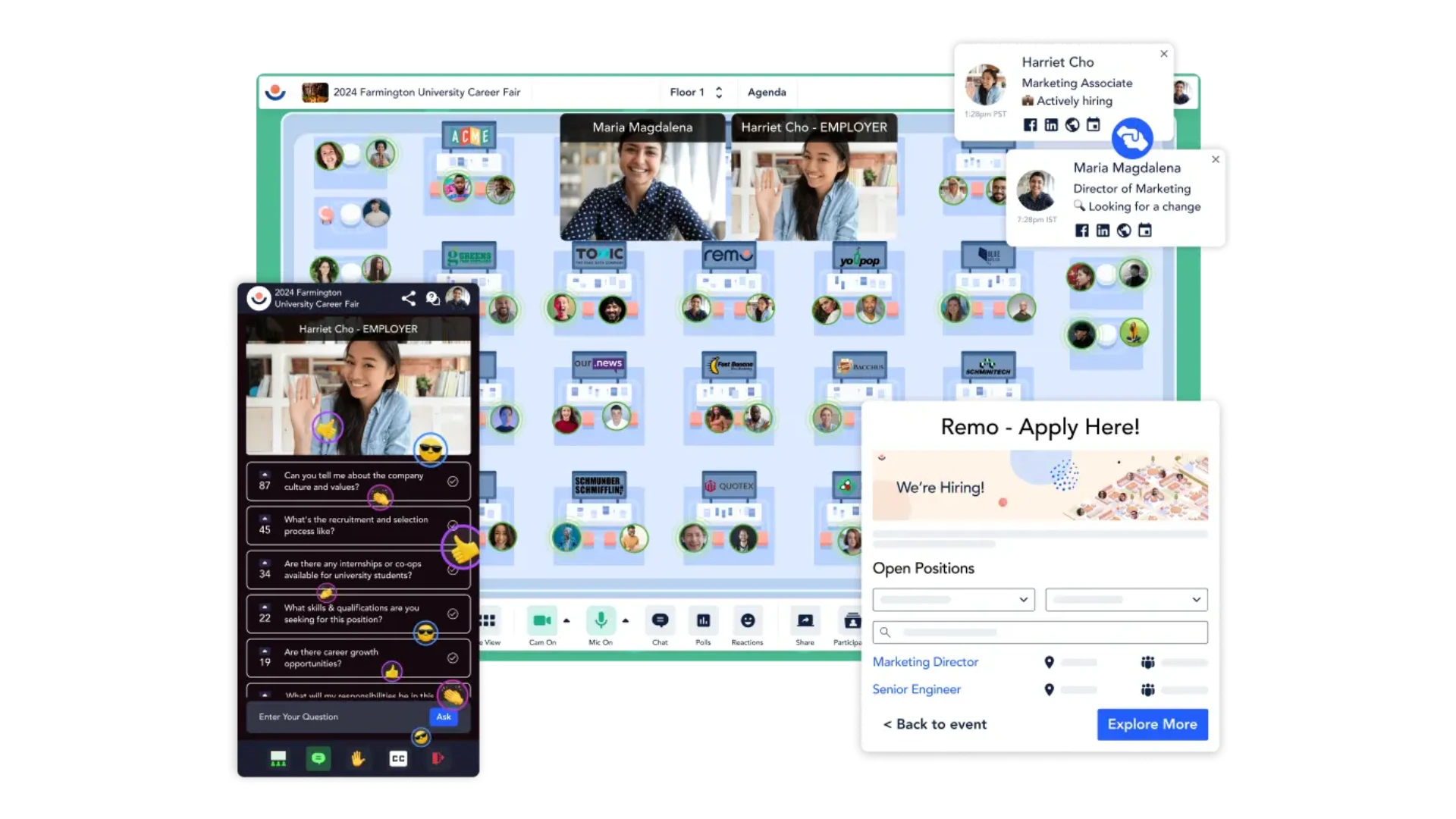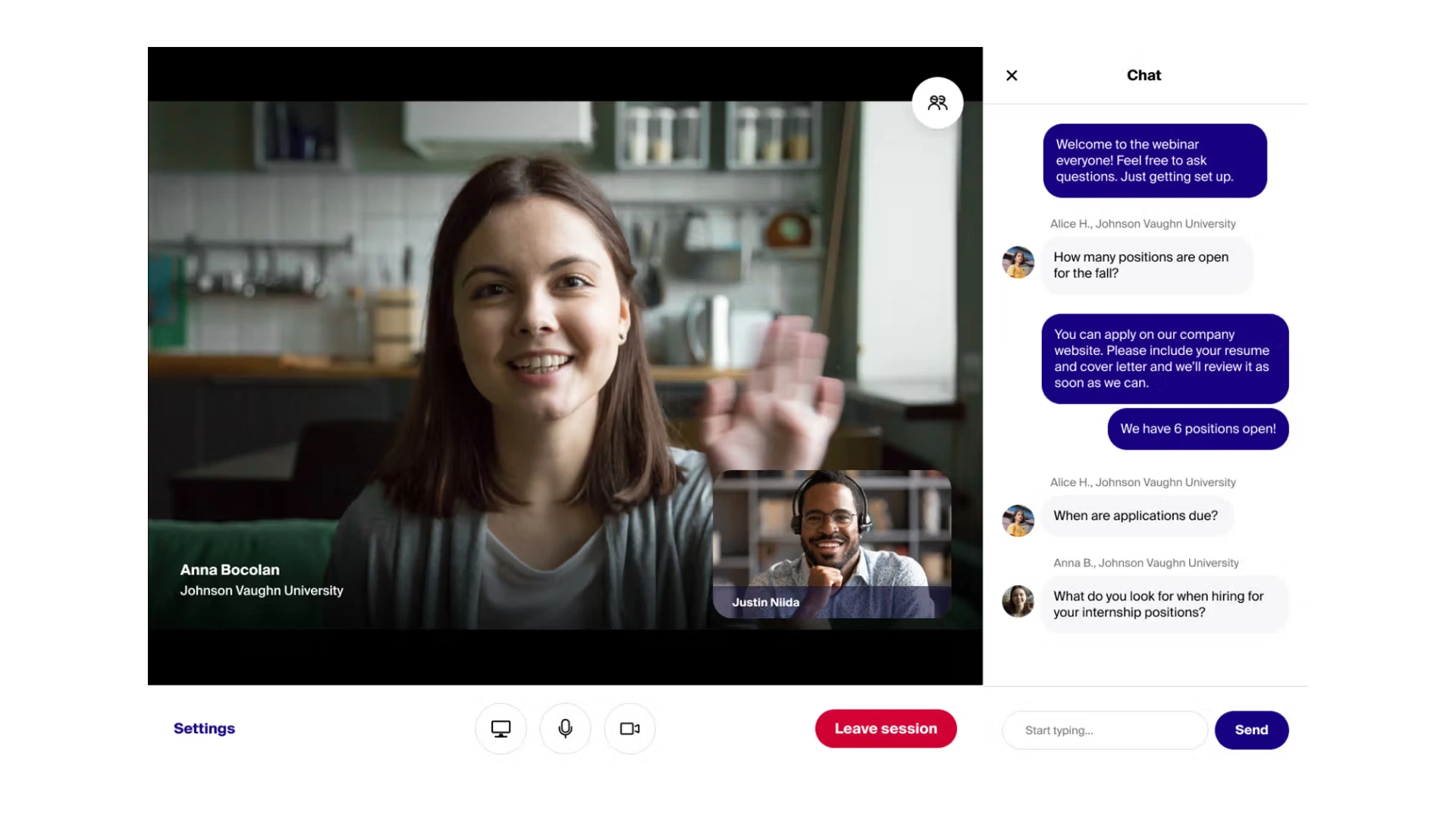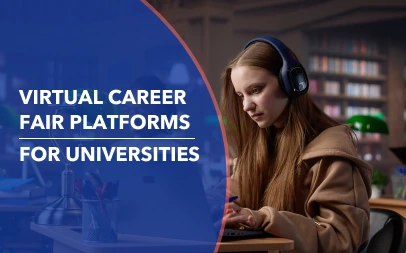Virtual Career Fair Platforms for Universities Comparison: Remo vs. Handshake vs. Brazen


Picture the energy of a campus career fair — students moving between booths, quick chats turning into opportunities, and recruiters comparing notes over coffee. That same spark is what the best virtual career fair platforms for universities now strive to recreate online.
Virtual fairs have moved from temporary fix to essential tool, connecting students and employers across distances that once limited opportunity. But, hosting them well takes more than a login link. Organizers must balance engagement, scale, and recruitment outcomes, making sure every student feels seen and every employer gets real value.
Three major virtual career fair platforms lead the space, each with its own approach:
- Remo, a networking-first platform that captures the buzz of in-person fairs.
- Handshake, a structured, profile-based system built into the campus career network.
- Brazen, focused on automation and high-volume recruiting efficiency.
In this guide, we’ll compare these virtual career fair platforms for universities side by side, exploring how they deliver on connection, usability, and results, so you can choose the right fit for your next fair.
{{table-of-contents}}
Why Virtual Career Fair Platform Choice Matters

For university event organizers, the virtual event platform shapes everything, from how easily students find employers to how engaged recruiters feel by the end of the day. A great virtual fair doesn’t just run smoothly; it feels alive.
The challenge is striking a balance. Too much structure, and the event becomes a series of scheduled calls. Too little, and students wander without clear direction. The right tool bridges both worlds, providing organization without losing the spontaneity that makes networking valuable.
Beyond logistics, platform choice also influences perception. When a fair feels intuitive and welcoming, students participate longer and employers come back next semester. When it feels flat or transactional, they don’t.
That’s why understanding how today’s leading virtual career fair platforms for universities, Remo, Handshake, and Brazen, approach engagement, scale, and outcomes is so important. Each was built for the same goal but takes a different route to get there.
Next, we’ll explore how these three platforms compare, and what kind of experience they really create for universities, students, and employers alike.
Top 3 Virtual Career Fair Platform for Universities
Virtual career fair platforms for universities may share the same goal, connecting students and employers online, but how they get there varies widely. Some focus on logistics and scheduling, while others emphasize scale or automation. And then there’s Remo, which prioritizes what many organizers say is hardest to achieve virtually: real immersive interaction.
Below, we begin with a closer look at Remo, followed by Handshake and Brazen, to understand how each platform shapes the event experience in its own way.
This guide focuses specifically on platforms used by universities, for a broader roundup you can also explore our 10 best virtual career fair platforms article.
1. Remo — The Engagement-First Experience

Remo turns virtual career fairs into something that actually feels social. Instead of logging into a list of meeting links or directory of booths, students enter a visual, floor plan filled with tables and booths. Each table represents an employer, students can “walk” over, join a live video chat, and leave when they’re ready, just like they would if attending in-person. The result is a fair that feels more like walking through a buzzing campus hall than sitting behind a screen.
Organizer Experience
On Remo, event organizers get control without the clutter.
- Choose from immersive floor plans or design a branded layout that mirrors your campus.
- Run everything, from keynotes to networking, inside one virtual space.
- Track participation in real time with analytics on attendance and virtual table activity.
Unlike structured tools such as Handshake, which require multiple session links, Remo keeps the entire event under one roof, simplifying the experience for organizers, students, and employers alike.
Student Experience
Students often say Remo feels more natural than other platforms.
- Conversations happen in small groups, lowering pressure and encouraging participation.
- No downloads or complex signups, they just click and join from a browser.
- Built-in accessibility features (captions, mobile support) make it inclusive for all.
This environment encourages discovery and confidence, two outcomes that structure-driven platforms often struggle to deliver. On Remo, students can move freely between tables, explore employer booths at their own pace, and spark spontaneous conversations that mirror a real in-person fair. That mobility creates the serendipitous “I wasn’t planning to talk to them, but I’m glad I did” moments other platforms tend to miss.
By contrast, appointment-based platforms limit interactions to pre-selected employers, reducing the chance for students to stumble into new opportunities or industries they hadn’t considered. For universities, that freedom to explore is crucial, discovery helps students build confidence, ask more questions, and leave the event with a broader sense of what’s possible.
Employer Experience
Recruiters enjoy flexibility too.
- Multiple team members can host their own tables at once.
- Screen sharing and whiteboards make it easy to review portfolios or show company culture.
- Free-flowing chats replace queues and scheduling grids with real conversations.
Employers get to meet more students organically, and that spontaneity often leads to stronger follow-up engagement.
Remo — Pricing
Remo’s Pricing has three flexible pricing tiers designed for universities of all sizes:
- Starter: Starting at $299/month (quarterly or annual subscription)
Includes up to 200 attendees per event, 20 organizer licenses, immersive 3D floor plans, polls, quizzes, Q&A, and free or paid ticketing options. Perfect for recurring career fairs or events that prioritize engagement.
- One-Time Events: Starting at $699 per event
Ideal for single large-scale career fairs. Includes all Starter features plus additional organizers, custom layouts, and flexible attendee scaling. Pay only for the features you need.
- Enterprise: Custom quote
Designed for institutions running multiple branded events year-round. Includes unlimited event spaces, SSO options, dedicated customer success support, and advanced engagement analytics.
Remo also provides discounted pricing for startups, small businesses, and non-profit organizations. They also offer a free 14-day trial to test the platform. Check out Remo’s pricing page for more detailed information.
User Reviews
“Remo was easy and convenient to use. I could drop in and out of conversations with employers effortlessly.”
— Haikal Y., Small Business (Career Fair Attendee)
“I loved the ease of use and the ability to be face-to-face in virtual rooms.”
— Kamita M., Director of Workforce Development
“Very nice concept for virtual conferences — the layout design was well done. This was my first experience in a virtual employer setting and it felt natural and well-designed.”
— Verified Reviewer
Highlights and Considerations
Remo’s biggest strength is how natural it feels. Its design encourages networking instead of formality, helping universities boost participation and satisfaction scores. Organizers appreciate its simplicity, and students stay longer because the event feels approachable rather than transactional.
It’s worth noting that Remo focuses on engagement over heavy recruiting tools, it doesn’t include a purpose-built resume database or applicant tracking yet. However, organizers and employers can still get the tracking they want through Remo’s post-event reporting and integrations offered. Like most interactive platforms, it benefits from a short orientation at the start, but once attendees grasp the layout, navigation feels effortless.
2. Handshake — The Structured Campus Ecosystem

For universities invested in campus recruiting, Handshake is often a familiar part of the career services ecosystem. Many students already use it to browse job postings, manage resumes, and RSVP for employer events. When virtual career fairs became standard, Handshake extended its tools to support online fairs, giving institutions already using the platform the convenience of managing career services in one place.
Unlike Remo, which focuses on dynamic networking and live interaction, Handshake centers on structure and scheduling. It’s designed for predictability: employers set their schedules, students register for time slots, and meetings happen in timed blocks. That organization is its strength, and sometimes its limitation.
Organizer Experience
- Centralized setup where career center staff can create fairs, approve employers, and track signups from the same dashboard used for jobs and internships.
- Automated scheduling where recruiters manage 1:1 and group sessions and students pick available slots.
- Analytics-ready reporting where post virtual event metrics integrate easily with the university’s existing Handshake data.
For institutions that already depend on Handshake daily, this continuity is convenient. But customization is limited compared to visual platforms like Remo, which let organizers brand their event space, design sponsor booths, and manage everything in one interactive environment.
Student Experience
- Meetings are private and time-bound, making them feel structured and efficient.
- Student profiles automatically share academic data and resumes.
- Notifications ensure no one misses their session.
Still, the experience is more formal than social. Handshake works much like a student version of LinkedIn, strong for applications, but not built for easy discovery. Once sessions are full, students can’t freely explore new employers or drop into open conversations. And since many employers prefer candidates to apply through their own systems anyway, this lack of open discovery often leaves students with fewer chances to learn, ask questions, or find unexpected opportunities.
This is the key contrast with platforms like Remo, which prioritize real-time discovery and spontaneous, small-group conversations before the application step.
Employer Experience
- Predictable scheduling that allows recruiters to plan their day around reserved sessions.
- Integrated data that syncs all candidate interactions back to their employer dashboard.
- Consistent event experience that feels uniform and standardized.
However, some recruiters note that filter accuracy, especially when segmenting student lists by major or graduation year, could be improved. It occasionally surfaces mismatched profiles, creating extra prep work.
Handshake — Pricing
Handshake operates on an annual institutional license, negotiated based on enrollment size and platform scope. Pricing is typically bundled with the university’s broader Handshake career-services system, covering job postings, analytics, and event management.
This structure ensures deep integration but can be cost-prohibitive for smaller departments that only host a few virtual fairs each year.
User Reviews
“I’ve hired most of my interns through Handshake, so it’s definitely been a great tool for early-career recruiting.”
— Luccas L., Sr. Recruiter, Early Careers (Enterprise)
“There are fake job listings all over the platform now and companies that spam these, but Handshake does not seem to care. ”
— Danielle H., Student
Highlights and Considerations
Handshake’s strengths lie in its structure and data integration. It works well for universities already embedded in its ecosystem and for employers who prefer orderly, scheduled interactions.
But there are trade-offs that students and employers frequently discuss. The rigid format can limit engagement, and the filtering tools aren’t always precise, a common frustration on Reddit, where students note receiving outreach from irrelevant or low-quality postings. Many also describe sifting through spammy roles, loosely defined “marketing” or “sales” positions, or companies that feel poorly vetted. While there are strong opportunities on the platform, finding them often requires digging through noise.
Pricing can also be a concern. Handshake’s enterprise-level licensing often fits large institutions better than smaller programs. In contrast, Remo’s flexible, event-based pricing gives smaller universities and departments the option to host fairs without long-term contracts or system-wide commitments.
3. Brazen — The Recruiting Automation Powerhouse

Before most universities went virtual, Brazen had already been hosting online hiring events for corporate and government recruiters. Now part of Radancy, it remains focused on helping organizations manage large-scale recruiting efficiently. Rather than replicating the energy of an in-person fair, Brazen emphasizes structure, automation, and measurable outcomes.
What makes it distinctive is its text-first communication model. Conversations begin in a chat window and can escalate to audio or video only if both parties choose. This approach supports volume and speed, recruiters can manage multiple conversations simultaneously, but it also creates emotional distance. In contrast, Remo’s video-first format puts students and employers face to face immediately, building rapport from the very first interaction.
Organizer Experience
- Booth-based setup where organizers create branded employer booths with logos, job listings, and company information.
- Automation tools that use screening questions, candidate routing, and chat queues to keep large fairs running smoothly.
- Detailed reporting that provides exportable data on booth visits, chat counts, and candidate flow.
The automation makes Brazen ideal for large consortium or statewide events, though it can feel heavy for smaller university fairs.
Student Experience
- Conversations start as text, with the option to escalate to video.
- Wait times are visible, which helps manage expectations.
- Transcripts save automatically for easy follow-up.
While the chat-first format can reduce pressure for nervous students, it also limits the natural flow of conversation. Many report that typing before talking feels impersonal, a contrast to Remo’s immediate, video-based networking, which mirrors a real conversation from the start.
Employer Experience
- High-volume throughput that allows recruiters to manage multiple chats simultaneously.
- Screening automation that filters candidates efficiently before the event.
- Post-event data that includes exportable transcripts and performance summaries.
This setup is perfect for large recruiting teams that need efficiency and quick candidate sorting, but less ideal for employers who prefer conversational depth, brand storytelling, or the ability to read body language, a major factor in early screening that text-based chats simply can’t replicate.
User Reviews
“Brazen manages participants well with organized queues for each booth.”
— Ryan LaGrange, Manager of Workforce Development (Government Administration)
“I’d like there to be more than one recruiter allowed in a single booth. A two-way video option would also make conversations more personal. Screen sharing or document sharing would be great for reviewing benefits information.”
— Verified User, Professional in Human Resources (Enterprise)
Brazen (Radancy) — Pricing
Brazen follows an enterprise-level pricing model, with quotes tailored to each client’s event volume and requirements. Contracts often cover multiple events annually or institution-wide recruiting programs.
Exact pricing is not publicly available, but it generally aligns with large-scale enterprise software costs. For smaller institutions, Remo’s published pricing offers a clearer entry point, allowing departments to run interactive, video-based events without long-term contracts or negotiation cycles.
Highlights and Considerations
Brazen’s biggest strengths are automation, scale, and data. It’s a powerhouse for recruiters handling hundreds of chats an hour and for universities running regional or multi-institutional events.
Still, many organizers say a two-way video option would make candidate interactions feel more personal. The ability to screen share or exchange documents would also help recruiters review portfolios or benefits materials in real time. Another frequent request is more robust analytics, especially for post-event performance tracking.
Virtual Career Fair Platforms for Universities Comparison
Every platform takes a different approach to the same challenge: helping students and employers connect online. This quick comparison highlights how the top virtual career fair platforms for universities, Remo, Handshake, and Brazen (Radancy), perform across key factors like engagement, setup, and scalability.
Matching Virtual Career Fair Platform for Universities to Your Event Goals
No two university career fairs are exactly alike, and neither are the tools that power them. The best virtual career fair platform for your university depends on what you want to prioritize: engagement, structure, or scale. Here’s how to decide.
- Choose Remo for engagement-heavy or hybrid fairs
If your goal is to replicate the energy of an in-person fair, Remo is the clear fit. Its video-first design, interactive floor plans, and small-group tables foster natural networking that keeps students engaged longer. It’s also ideal for hybrid events, where in-person and virtual attendees can connect in the same event environment. For organizers focused on relationship-building and student experience, Remo delivers the most human approach.
- Choose Handshake for controlled, data-driven fairs
For universities that live inside the Handshake ecosystem, staying with it for virtual fairs ensures continuity. It centralizes job postings, student profiles, and recruiter data in one place, perfect for compliance and reporting. The trade-off is engagement: its scheduled sessions are structured but lack spontaneity. If data consistency and process management outrank interaction quality, Handshake might make sense for you.
- Choose Brazen (Radancy) for large recruiting pipelines
When scale and automation matter most, Brazen leads. Its chat-based system and candidate routing tools help recruiters manage hundreds of interactions in a single event. While the experience feels more transactional than conversational, it excels at efficiency. For consortium fairs, multi-university collaborations, or employer-sponsored hiring drives, Brazen’s automation can handle the heavy lifting.
Mixing Virtual Career Fair Platforms for Maximum Impact
Many universities now combine platforms strategically, for example, using Handshake for registration and data capture, then hosting networking segments in Remo. This layered approach blends structure with engagement, ensuring both administrators and attendees get the experience they need.
Finding the Right Virtual Career Fair Platform for Your University’s Goals
Virtual career fairs have evolved from logistical stopgaps into essential tools for university career services. Whether your priority is engagement, structure, or automation, the platform you choose will define how students and employers connect, and how memorable those interactions feel.
Among today’s leading virtual career fair platforms for universities, Remo, Handshake, and Brazen (Radancy) each offer distinct advantages. Handshake streamlines organization and reporting, Brazen excels at automation and scale, and Remo transforms online events into immersive, face-to-face experiences. For universities that value connection and participation, Remo’s video-first design stands out as the most engaging option.
The best solution often depends on your goals, or might even be a mix of tools. But one truth applies to every event: technology should never get in the way of connection. Ready to see how Remo can elevate your next university career fair? Book a demo and discover how easy it can be to create events that truly bring people together online.
Frequently Asked Questions about Virtual Career Fair Platforms of Universities
1. How do recruiters and students interact on virtual career fair platforms?
Most platforms connect students and employers through video, chat, or scheduled sessions. Remo offers open, video-first networking that feels like walking through a real fair, while Handshake and Brazen (Radancy) rely on structured meetings or text chats.
2. What features support video, chat, and group or 1:1 networking sessions?
Remo enables face-to-face video, group tables, and private chats all in one space. Handshake provides scheduled video meetings, and Brazen starts with text that can escalate to video if both sides agree.
3. How easy is the platform to use for both students and employers?
Remo runs entirely in the browser, so setup takes minutes. Handshake integrates with campus systems but offers less customization, while Brazen manages volume well yet feels more procedural for new users.
4. Which virtual career fair platform for universities is best overall?
It depends on your goals. Remo leads in engagement, Handshake in structure, and Brazen in automation. Many universities mix tools to balance connection and data.
5. What kind of analytics and reporting do these platforms provide?
Handshake integrates with institutional data, Brazen offers strong recruiting metrics, and Remo focuses on engagement analytics like attendance and participation. Each provides downloadable reports for post-event insights.
6. Are these platforms accessible for hybrid or remote students?
Yes. All three support browser-based access, but Remo’s layout and mobile compatibility make hybrid events especially seamless. Students and employers can join from anywhere without losing interaction quality.







.webp)




















